Java Review - 并发编程_DelayQueue原理&源码剖析
Posted 小小工匠
tags:
篇首语:本文由小常识网(cha138.com)小编为大家整理,主要介绍了Java Review - 并发编程_DelayQueue原理&源码剖析相关的知识,希望对你有一定的参考价值。
文章目录

概述
DelayQueue并发队列是一个无界阻塞延迟队列,队列中的每个元素都有个过期时间,当从队列获取元素时,只有过期元素才会出队列。
队列头元素是最快要过期的元素。

类图结构
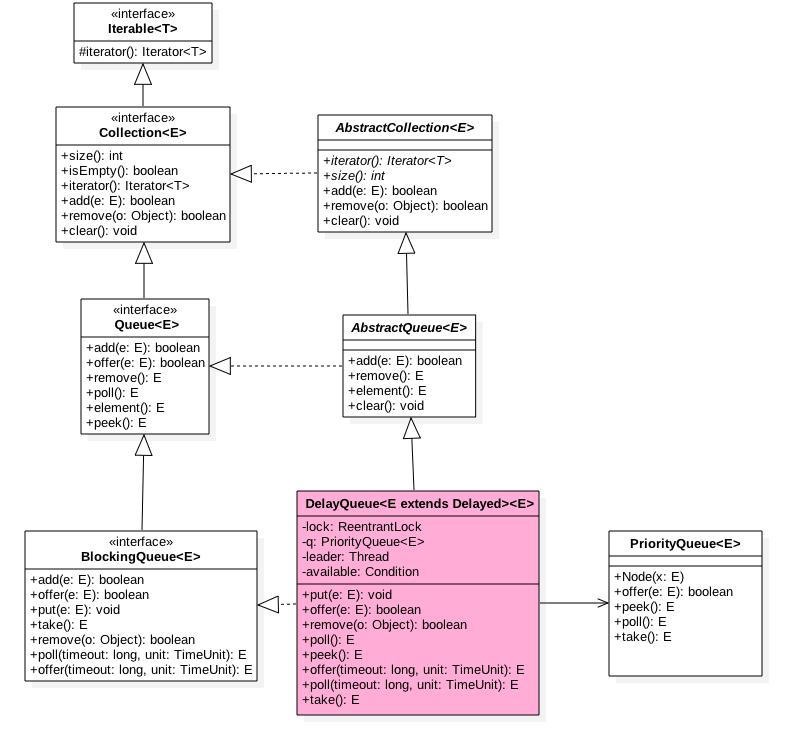
由该图可知
-
DelayQueue内部使用PriorityQueue存放数据,使用ReentrantLock实现线程同步。
-
另外,队列里面的元素要实现Delayed接口,由于每个元素都有一个过期时间,所以要实现获知当前元素还剩下多少时间就过期了的接口,由于内部使用优先级队列来实现,所以要实现元素之间相互比较的接口。
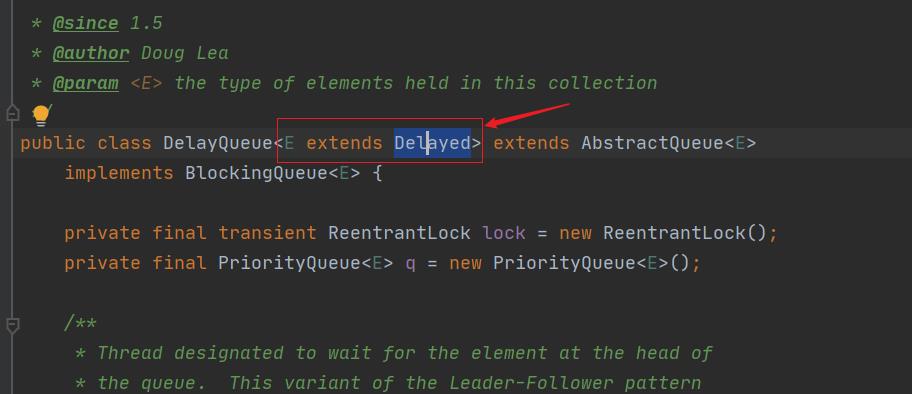
/**
* A mix-in style interface for marking objects that should be
* acted upon after a given delay.
*
* <p>An implementation of this interface must define a
* @code compareTo method that provides an ordering consistent with
* its @code getDelay method.
*
* @since 1.5
* @author Doug Lea
*/
public interface Delayed extends Comparable<Delayed>
/**
* Returns the remaining delay associated with this object, in the
* given time unit.
*
* @param unit the time unit
* @return the remaining delay; zero or negative values indicate
* that the delay has already elapsed
*/
long getDelay(TimeUnit unit);
- 条件变量available与lock锁是对应的,其目的是为了实现线程间同步
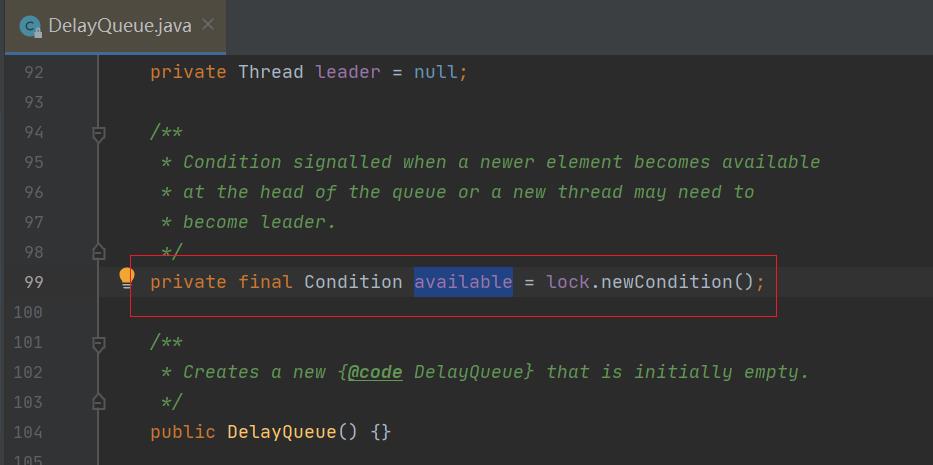
private final transient ReentrantLock lock = new ReentrantLock();
/**
* Condition signalled when a newer element becomes available
* at the head of the queue or a new thread may need to
* become leader.
*/
private final Condition available = lock.newCondition();
- 其中leader变量的使用基于Leader-Follower模式的变体,用于尽量减少不必要的线程等待。当一个线程调用队列的take方法变为leader线程后,它会调用条件变量available.awaitNanos(delay)等待delay时间,但是其他线程(follwer线程)则会调用available.await()进行无限等待
leader线程延迟时间过期后,会退出take方法,并通过调用available.signal()方法唤醒一个follwer线程,被唤醒的follwer线程被选举为新的leader线程。
/**
* Thread designated to wait for the element at the head of
* the queue. This variant of the Leader-Follower pattern
* (http://www.cs.wustl.edu/~schmidt/POSA/POSA2/) serves to
* minimize unnecessary timed waiting. When a thread becomes
* the leader, it waits only for the next delay to elapse, but
* other threads await indefinitely. The leader thread must
* signal some other thread before returning from take() or
* poll(...), unless some other thread becomes leader in the
* interim. Whenever the head of the queue is replaced with
* an element with an earlier expiration time, the leader
* field is invalidated by being reset to null, and some
* waiting thread, but not necessarily the current leader, is
* signalled. So waiting threads must be prepared to acquire
* and lose leadership while waiting.
*/
private Thread leader = null;

小Demo
import java.util.Random;
import java.util.concurrent.DelayQueue;
import java.util.concurrent.Delayed;
import java.util.concurrent.TimeUnit;
/**
* @author 小工匠
* @version 1.0
* @description: TODO
* @date 2021/12/19 23:05
* @mark: show me the code , change the world
*/
public class DelayQueueTest
static class DelayedEle implements Delayed
private final long delayTime; //延迟时间
private final long expire; //到期时间
private String data; //数据
public DelayedEle(long delay, String data)
delayTime = delay;
this.data = data;
expire = System.currentTimeMillis() + delay;
/**
* 剩余时间=到期时间-当前时间
*/
@Override
public long getDelay(TimeUnit unit)
return unit.convert(this.expire - System.currentTimeMillis(), TimeUnit.MILLISECONDS);
/**
* 优先队列里面优先级规则
*/
@Override
public int compareTo(Delayed o)
return (int) (this.getDelay(TimeUnit.MILLISECONDS) - o.getDelay(TimeUnit.MILLISECONDS));
@Override
public String toString()
final StringBuilder sb = new StringBuilder("DelayedElement");
sb.append("delay=").append(delayTime);
sb.append(", expire=").append(expire);
sb.append(", data='").append(data).append('\\'');
sb.append('');
return sb.toString();
public static void main(String[] args) throws InterruptedException
// 1 创建延时队列
DelayQueue<DelayedEle> delayQueue = new DelayQueue<DelayedEle>();
// 2 创建延时任务
Random random = new Random();
for (int i = 0; i < 10; i++)
DelayedEle ele = new DelayedEle(random.nextInt(500), "task-" + i);
delayQueue.offer(ele);
System.out.println("开始操作,delayQueue队列大小为:" + delayQueue.size());
// 3 依次取出任务并打印
DelayedEle delayedEle = null;
try
// 3.1 循环,如果想避免虚假唤醒,则不能把全部元素都打印出来
for (; ; )
// 3.2 获取过期的任务并打印
while ((delayedEle = delayQueue.take()) != null)
System.out.println(delayedEle.toString());
catch (InterruptedException e)
e.printStackTrace();
首先创建延迟任务DelayedEle类,其中delayTime表示当前任务需要延迟多少ms时间过期,expire则是当前时间的ms值加上delayTime的值。
另外,实现了Delayed接口,实现了long getDelay(TimeUnit unit)方法用来获取当前元素还剩下多少时间过期,实现了int compareTo(Delayed o)方法用来决定优先级队列元素的比较规则。
在main函数内首先创建了一个延迟队列,然后使用随机数生成器生成了10个延迟任务,最后通过循环依次获取延迟任务,并打印。运行上面代码,一个可能的输出如下所示。
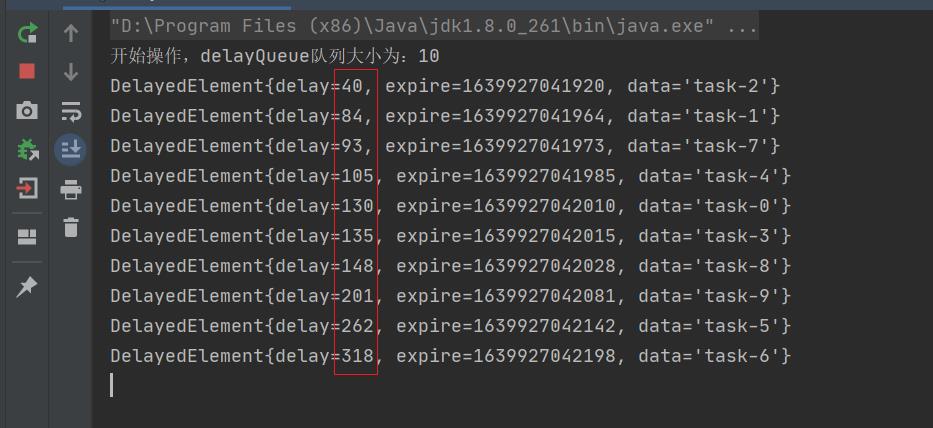
可见,出队的顺序和delay时间有关,而与创建任务的顺序无关。
核心方法&源码解读
offer操作
插入元素到队列,如果插入元素为null则抛出NullPointerException异常,否则由于是无界队列,所以一直返回true。插入元素要实现Delayed接口。
/**
* Inserts the specified element into this delay queue.
*
* @param e the element to add
* @return @code true
* @throws NullPointerException if the specified element is null
*/
public boolean offer(E e)
final ReentrantLock lock = this.lock; // 1
lock.lock();
try
q.offer(e);
if (q.peek() == e) // 2
leader = null;
available.signal();
return true;
finally
lock.unlock();
- 首先获取独占锁,然后添加元素到优先级队列,由于q是优先级队列,所以添加元素后,调用q.peek()方法返回的并不一定是当前添加的元素
- 如果代码(2)判断结果为true,则说明当前元素e是最先将过期的,那么重置leader线程为null,这时候激活avaliable变量条件队列里面的一个线程,告诉它队列里面有元素了。

take操作
获取并移除队列里面延迟时间过期的元素,如果队列里面没有过期元素则等待。
/**
* Retrieves and removes the head of this queue, waiting if necessary
* until an element with an expired delay is available on this queue.
*
* @return the head of this queue
* @throws InterruptedException @inheritDoc
*/
public E take() throws InterruptedException
final ReentrantLock lock = this.lock;
lock.lockInterruptibly();
try
for (;;)
// 1 获取但不移除队首元素
E first = q.peek();
if (first == null)
available.await(); // 2
else
long delay = first.getDelay(NANOSECONDS);
if (delay <= 0) // 3
return q.poll();
first = null; // don't retain ref while waiting
if (leader != null) // 4
available.await();
else
Thread thisThread = Thread.currentThread();
leader = thisThread; // 5
try
available.awaitNanos(delay); // 6
finally
if (leader == thisThread)
leader = null;
finally
if (leader == null && q.peek() != null) // 7
available.signal();
lock.unlock();
-
首先获取独占锁lock。假设线程A第一次调用队列的take()方法时队列为空,则执行代码(1)后first==null,所以会执行代码(2)把当前线程放入available的条件队列里阻塞等待。
-
当有另外一个线程B执行offer(item)方法并且添加元素到队列时,假设此时没有其他线程执行入队操作,则线程B添加的元素是队首元素,那么执行q.peek()。
-
e这时候就会重置leader线程为null,并且激活条件变量的条件队列里面的一个线程。此时线程A就会被激活。
-
线程A被激活并循环后重新获取队首元素,这时候first就是线程B新增的元素,可知这时候first不为null,则调用first.getDelay(TimeUnit.NANOSECONDS)方法查看该元素还剩余多少时间就要过期,如果delay<=0则说明已经过期,那么直接出队返回。
-
否则查看leader是否为null,不为null则说明其他线程也在执行take,则把该线程放入条件队列。如果这时候leader为null,则选取当前线程A为leader线程,
-
然后执行代码(5)等待delay时间(这期间该线程会释放锁,所以其他线程可以offer添加元素,也可以take阻塞自己),剩余过期时间到后,线程A会重新竞争得到锁,然后重置leader线程为null,重新进入循环,这时候就会发现队头的元素已经过期了,则会直接返回队头元素。
-
在返回前会执行finally块里面的代码(7),代码(7)执行结果为true则说明当前线程从队列移除过期元素后,又有其他线程执行了入队操作,那么这时候调用条件变量的singal方法,激活条件队列里面的等待线程。

poll操作
获取并移除队头过期元素,如果没有过期元素则返回null。
/**
* Retrieves and removes the head of this queue, or returns @code null
* if this queue has no elements with an expired delay.
*
* @return the head of this queue, or @code null if this
* queue has no elements with an expired delay
*/
public E poll()
final ReentrantLock lock = this.lock;
lock.lock();
try
E first = q.peek();
// 如果队列为空,或者不为空但是对头元素没有过期,则返回null
if (first == null || first.getDelay(NANOSECONDS) > 0)
return null;
else
return q.poll();
finally
lock.unlock();
首先获取独占锁,然后获取队头元素,如果队头元素为null或者还没过期则返回null,否则返回队头元素。

size操作
计算队列元素个数,包含过期的和没有过期的。
public int size()
final ReentrantLock lock = this.lock;
lock.lock();
try
return q.size();
finally
lock.unlock();
先获取独占锁,然后调用优先级队列的size方法。
小结
DelayQueue队列内部使用PriorityQueue存放数据,使用ReentrantLock实现线程同步。
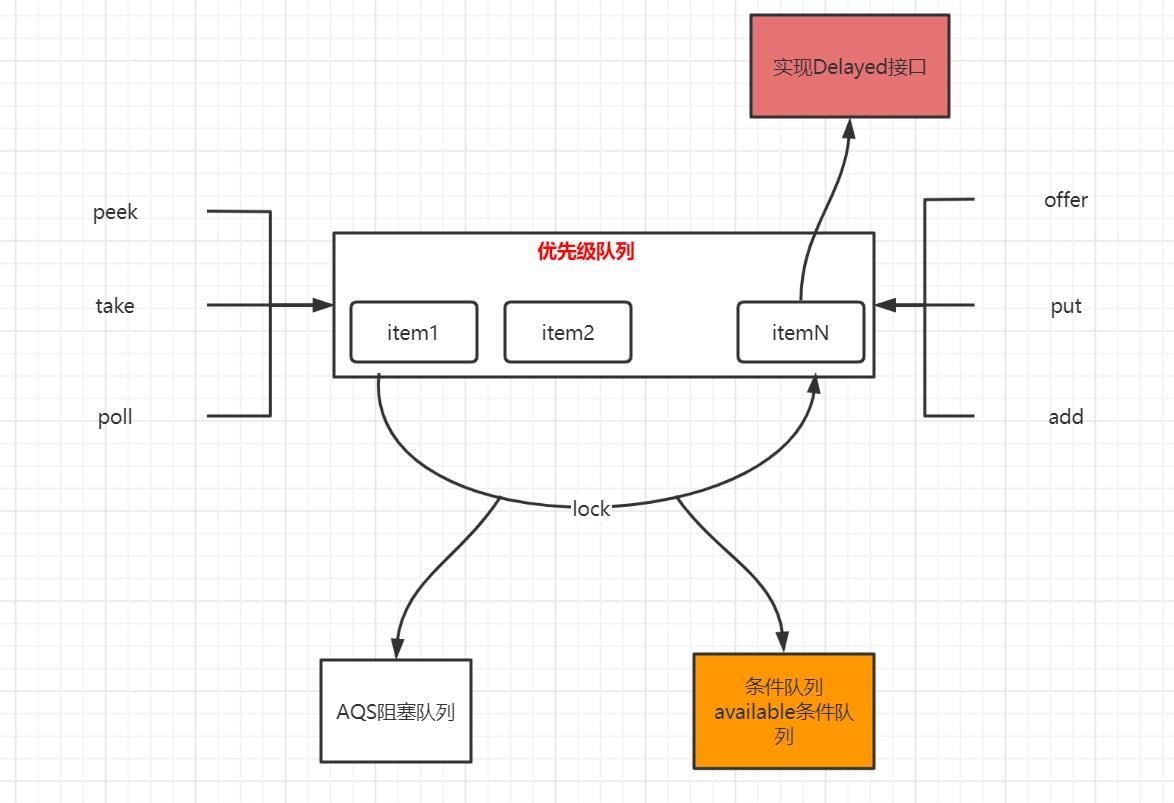
另外队列里面的元素要实现Delayed接口,其中一个是获取当前元素到过期时间剩余时间的接口,在出队时判断元素是否过期了,一个是元素之间比较的接口,因为这是一个有优先级的队列。
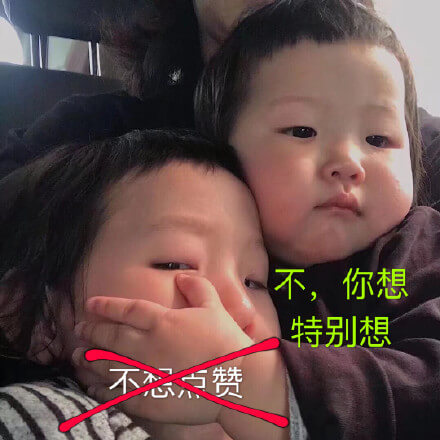
以上是关于Java Review - 并发编程_DelayQueue原理&源码剖析的主要内容,如果未能解决你的问题,请参考以下文章